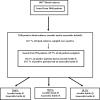Relevance of routine use of the anaerobic blood culture bottle
- PMID: 17581942
- PMCID: PMC1951263
- DOI: 10.1128/JCM.00059-07
Relevance of routine use of the anaerobic blood culture bottle
Abstract
Using the BacT/Alert automated system, we conducted a 1-year retrospective study on blood cultures, focusing on the relevance of routine use of the anaerobic bottle. The rate of patients with positive blood cultures was 19.7%. Among these, 13.5% had a positive anaerobic bottle in the absence of any aerobic bottle, and 2/3 of these grew with nonobligate anaerobes. These patients were hospitalized in 20 out of 26 wards of the hospital group. For 65.4% of the monomicrobial-positive blood cultures growing Enterobacteriaceae, the anaerobic bottle detected growth earlier than the corresponding aerobic bottle. These data suggest that, in our institution, the use of an anaerobic bottle is still relevant.
Figures


References
-
- Blairon, L., Y. De Gheldre, B. Delaere, A. Sonet, A. Bosly, and Y. Glupczynski. 2006. A 62-month retrospective epidemiological survey of anaerobic bacteraemia in a university hospital. Clin. Microbiol. Infect. 12:527-532. - PubMed
-
- Cockerill, F. R., III, J. W. Wilson, E. A. Vetter, K. M. Goodman, C. A. Torgerson, W. S. Harmsen, C. D. Schleck, D. M. Ilstrup, J. A. Washington II, and W. R. Wilson. 2004. Optimal testing parameters for blood cultures. Clin. Infect. Dis. 38:1724-1730. - PubMed
-
- Comité de l'antibiogramme de la Société Française de Microbiologie. 2003. Comité de l'antibiogramme de la Société Française de Microbiologie report 2003. Int. J. Antimicrob. Agents 21:364-391. - PubMed
-
- Cornish, N., B. A. Kirkley, K. A. Easley, and J. A. Washington. 1999. Reassessment of the routine anaerobic culture and incubation time in the BacT/Alert FAN blood culture bottles. Diagn. Microbiol. Infect. Dis. 35:93-99. - PubMed
-
- Gransden, W. R., S. J. Eykyn, and I. Phillips. 1991. Anaerobic bacteremia: declining rate over a 15-year period. Rev. Infect. Dis. 13:1255-1256. - PubMed
MeSH terms
LinkOut - more resources
Full Text Sources
Medical

